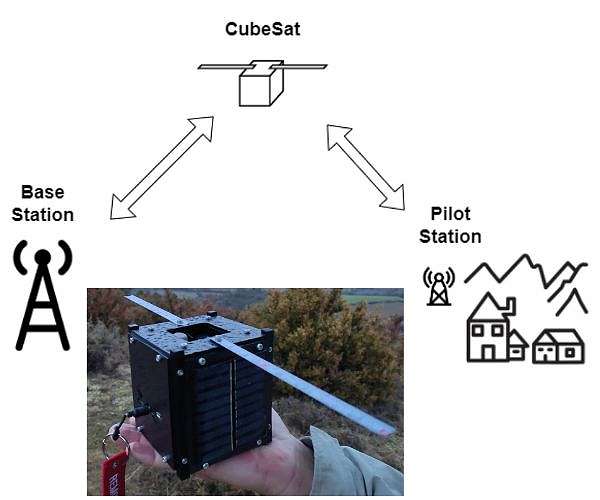A nanosatellite and a hot air balloon for emergency broadband anywhere by Staff Writers Barcelona, Spain (SPX) Nov 24, 2023 Ninety-five per cent of the planet’s population has access to broadband internet, via cable or a mobile network. However, there are still some places and situations in which staying connected can be very difficult. Quick responses are necessary in emergency situations, such as after an earthquake or during a conflict.
So too are reliable telecommunications networks that are not susceptible to outages and damage to infrastructure, networks can be used to share data that is vital for people’s well-being. A recent scientific article, published as open access, proposes the use of nanosatellites to provide comprehensive and stable coverage in areas that are hard to reach using long-range communications. It is based on the bachelor’s and master’s degree final projects of Universitat Oberta de Catalunya (UOC) graduate David N.
Barraca Ibort. Alongside Barraca Ibort, the paper is also authored by Raul Parada, a researcher at the Telecommunications Technological Centre of Catalonia (CTTC/CERCA) and a course instructor with the UOC’s Faculty of Computer Science, Multimedia and Telecommunications; Carlos Monzo, a researcher and member of the same faculty; and Victor Monzon, a researcher at the Interdisciplinary Centre for Security Reliability and Trust at the University of Luxembourg. From volcanoes to climate disasters: the importance of a quick response The number and financial cost of extreme weather events has constantly increased in recent decades according to the World Meteorological Organization (WMO).
Climate change has vastly increased the likelihood of climate disasters occurring all over the planet. However, thanks to improvements to emergency and early warning services, the increase in extreme events has not led to an increase in the number of victims. The ability to anticipate and react to an emergency situation is crucial for minimizing damage.
Climate disasters are the latest additions to an already long list of natural disasters, including earthquakes, volcanic eruptions, landslides and tsunamis, and emergencies caused by humans, such as wars, accidents and damage to infrastructure. In all of those situations, having a reliable telecommunications system which can be used to exchange information is essential for reacting quickly and on a coordinated basis in situations in which every second counts. This is where the technological solution proposed by the researcher team.
“Our project provides a solution that means that a communications network to provide help in emergency situations can be established quickly,” explained Monzo. “It uses equipment that offers a communications service quickly, when it would not otherwise be possible. It is especially designed for emergency services, so that they can work in a safer and more coordinated way in complex situations.
” A printed satellite and a hot air balloon The solution proposed by the researchers involves a rapid deployment system consisting of three components – two terrestrial and one non-terrestrial: a CubeSat (a nanosatellite design standard). The components on the ground are a pilot telecommunications station, deployed at the location where the emergency happens, and a base station. The CubeSat can connect the two places from anywhere, acting as a repeater and making it possible for users of the network to share information wirelessly.
All three components are equipped with long-range (LoRa) radio technology, and allow for the creation of a vast communications area. The CubeSat is a small nanosatellite that can be created from scratch using a 3D printer in just 90 minutes, and launched over the disaster area using a hot air balloon. The route that the balloon will follow can be determined by a prior simulation that takes the characteristics of the balloon and the meteorology of the area into account.
The CubeSat is also equipped with a GPS system that means it can be retrieved and reused. “Our solution enables communication over long distances, as well as providing a scalable system for a large number of users that is reusable anywhere and at any time,” said Parada, researcher with Sustainable Artificial Intelligence research unit at the CTTC. “We chose CubeSat as for communications in difficult environments due to its speed of deployment and functioning,” he said.
“It operates independently of current communication systems, which may be damaged during a disaster, and enables long-range communication. ” After the first successful tests, the system will continue to be tested in different environments, and will also be subjected to experiments with an energy system powered by photovoltaic panels, so that the solution can be completely autonomous. “Our solution is designed to provide a rapid service in complex scenarios, and as such we have prioritized its ease of deployment over its use as a telecommunications solution in normal situations, where other infrastructures would be more suitable,” concluded Monzo.
“The next step is to work on the services that could be included in this type of infrastructure, minimizing deployment times and ensuring it can be used in a wide range of situations. ” Research Report: LoRa-Based Low-Cost Nanosatellite for Emerging Communication Networks in Complex Scenarios Related Links UOC Open University of Catalonia – Satellite-based Internet technologies SEO Powered Content & PR Distribution. Get Amplified Today.
PlatoData. Network Vertical Generative Ai. Empower Yourself.
Access Here. PlatoAiStream. Web3 Intelligence.
Knowledge Amplified. Access Here. PlatoESG.
Carbon, CleanTech, Energy, Environment, Solar, Waste Management. Access Here. PlatoHealth.
Biotech and Clinical Trials Intelligence. Access Here. Source: https://www.
spacedaily. com/reports/A_nanosatellite_and_a_hot_air_balloon_for_emergency_broadband_anywhere_999. html.
From: zephyrnet
URL: https://zephyrnet.com/a-nanosatellite-and-a-hot-air-balloon-for-emergency-broadband-anywhere-2/



